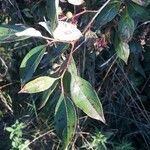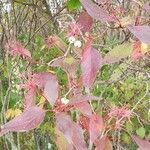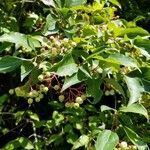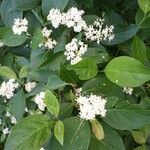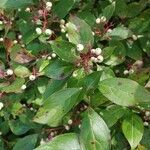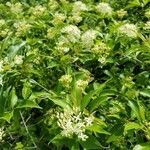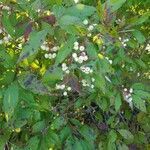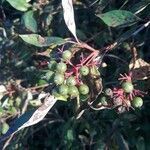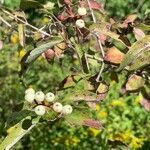Shrubs, to 5 m, flowering at 0.7 m; rhizomes present. Stems solitary, 2–10 dm apart; bark gray, brittle, verrucose, frequently forming small plates; branchlets pinkish brown, turning green-maroon, and later gray-maroon, 2 proximal internodes densely pubescent, distal internodes sparsely appressed-hairy; lenticels pale lenticular spots on new growth, uniformly scattered, especially on the distal internodes, protruding and extruding corky tissue on 2d year branches; pith white in 1st year branches, brown in older branches. Leaves: petiole 2–8 mm; blade lanceolate to ovate, 1.5–8 × 0.5–4 cm, base cuneate, apex acuminate to obtuse, abaxial surface pale green, adaxial surface green, turning maroon in full sun, both surfaces with hairs appressed, white to ferruginous; secondary veins 3–4(–5 on some sucker shoots) per side, evenly spaced. Inflorescences usually elongate, sometimes convex or pyramidal, 2.5–5 cm diam., peduncle 20–40 mm; branches and pedicels yellow-green, turning bright red. Flowers: hypanthium appressed-hairy; sepals 0.2–0.5 mm; petals white, 2.3–3 mm. Drupes usually white, occasionally pale blue, oblate-ellipsoid, laterally compressed, 4–8 mm diam.; stone oblate-ellipsoid, 3–6.5 mm diam., smooth, apex rounded to slightly pointed. 2n = 22.
More
Shrub 1–5 m, often forming thickets; twigs glabrous, at first green, soon becoming tan and eventually gray-brown; old bark mostly smooth and gray; pith white (tan); lvs lanceolate to elliptic, mostly 4–8 cm, a third to half as wide, abruptly acuminate, cuneate at base, often papillose-whitened beneath, sparsely strigose to glabrous on both sides, with 3 or 4(5) lateral veins to a side; infls often very numerous, convex to often pyramidal and paniculiform; fr at first leaden, becoming white (light blue), 5–8 mm, on reddish pedicels; 2n=22. Moist soil, woods, thickets, roadsides, and streambanks; Me. and s. Que. to s. Man., s. to Va., s. Ill., and Mo., adjoining but only slightly overlapping the range of no. 6 [Cornus stricta Lam.]; the two might well be considered vars. of one sp. (C. paniculata; ? C. foemina, a doubtful name)
Fields, meadows, roadsides, fencerows, swamp margins; at elevations up to 1,500 metres.
More
It is a temperate plant. It suits hardiness zone 3.
Can be grown by cuttings or seedlings. Seeds needs scarification.
